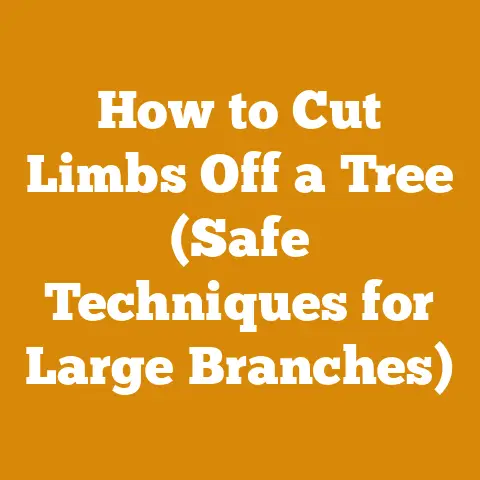Husqvarna 16 Inch Chainsaw Chain Fit Issues (Expert Guide)
Let’s get your Husqvarna 16-inch chainsaw chain fitting perfectly! I’ve seen firsthand how frustrating it is when a brand-new chain just won’t seat properly. Often, it’s a simple fix. In this guide, I’ll walk you through the common culprits and provide expert solutions to get your chainsaw roaring back to life quickly. I’ll share some of my personal experiences from years of felling trees and processing firewood, and give you the knowledge to avoid common mistakes.
Husqvarna 16-Inch Chainsaw Chain Fit Issues: An Expert Guide
A properly fitting chain is crucial for safe and efficient chainsaw operation. A chain that’s too tight can overheat and break, while one that’s too loose can derail and cause serious injury. This guide focuses specifically on Husqvarna chainsaws with a 16-inch bar, addressing common fitting problems and offering practical solutions. Whether you’re a seasoned logger or a weekend warrior preparing firewood, understanding chain fit is essential.
Why Chain Fit Matters
- Safety: A properly tensioned chain reduces the risk of kickback and chain derailment, both major safety hazards.
- Performance: A well-fitted chain cuts smoothly and efficiently, reducing strain on the saw’s engine and extending its lifespan.
- Chain Life: Proper tension minimizes wear and tear on the chain and bar, saving you money on replacements.
- Bar Life: Too tight and you wear the bar out quicker, too loose and it can damage the bar.
- Wood Quality: A correctly fitted and sharp chain will give you a cleaner cut.
Key Terms and Concepts
Before diving into the solutions, let’s define some key terms:
- Chain Pitch: The distance between any three consecutive rivets on the chain, divided by two. Common pitches are 3/8″ and .325″.
- Chain Gauge: The thickness of the drive links, which fit into the groove of the chainsaw bar. Common gauges are .050″ and .058″.
- Drive Links: The small pieces of metal on the chain that engage with the sprocket and guide the chain around the bar.
- Bar Groove: The channel in the chainsaw bar that the drive links of the chain run in.
- Tensioning Screw: The screw used to adjust the tension of the chain on the bar.
- Sprocket: The toothed wheel that drives the chain.
- Green Wood: Wood that has been freshly cut and has a high moisture content.
- Seasoned Wood: Wood that has been dried, reducing its moisture content.
- Kickback: The sudden and dangerous upward or backward movement of the chainsaw when the tip of the bar contacts an object.
Identifying the Problem
The first step is to accurately diagnose why your Husqvarna 16-inch chainsaw chain isn’t fitting correctly. Here are the most common scenarios:
1. Incorrect Chain Specifications
This is the most frequent cause. Chainsaws, bars, and chains must match in terms of pitch, gauge, and drive link count.
- The Wrong Pitch: Using a chain with the wrong pitch will prevent it from engaging properly with the sprocket.
- The Wrong Gauge: A chain with the wrong gauge will either be too loose in the bar groove (too thin) or won’t fit at all (too thick).
- Incorrect Drive Link Count: The drive link count is crucial. Too few, and the chain will be too short; too many, and it will be too long.
How to Diagnose:
- Check the Bar: Look for stamped markings on the chainsaw bar. These markings typically indicate the recommended chain pitch, gauge, and drive link count. My Husqvarna 455 Rancher bar, for example, clearly states “.325 .050 66DL.”
- Check the Chain Packaging: The chain packaging should also list the pitch, gauge, and drive link count.
- Compare: Ensure that the specifications on the bar match the specifications on the chain packaging.
Solution:
- Purchase a chain that matches the exact specifications of your chainsaw bar. Don’t guess! Double-check everything before buying.
Personal Experience: Once, I mistakenly grabbed a .325 pitch chain for a 3/8″ pitch bar. It seemed close enough, but the chain wouldn’t sit correctly on the sprocket, and I almost damaged the saw trying to force it. Always verify!
2. Worn Sprocket
A worn sprocket can cause the chain to fit loosely or jump off the bar. Over time, the teeth of the sprocket can become rounded or damaged, preventing the chain from engaging properly.
How to Diagnose:
- Visual Inspection: Examine the sprocket for wear. Look for rounded, chipped, or broken teeth.
- Chain Play: With the chain installed (but the saw turned off!), try to lift the chain away from the sprocket. Excessive play indicates a worn sprocket.
Solution:
- Replace the sprocket. Sprockets are relatively inexpensive and easy to replace. A new sprocket will ensure proper chain engagement and improve cutting performance.
- Consider replacing the spur sprocket with a rim sprocket. A rim sprocket can be replaced without replacing the entire clutch assembly.
Technical Detail: Sprockets are typically made of hardened steel. Wear occurs due to friction and impact from the chain. Regularly lubricating the chain helps to extend sprocket life.
3. Worn Bar
A worn chainsaw bar can also cause chain fit issues. The bar groove can widen over time, leading to a loose chain. The rails of the bar can also become uneven, causing the chain to wobble.
How to Diagnose:
- Bar Groove Width: Use a bar groove gauge to measure the width of the bar groove. If the groove is wider than the recommended specification, the bar is worn.
- Bar Rail Condition: Inspect the bar rails for uneven wear or damage. Run your finger along the rails to feel for irregularities.
- Bar Straightness: Check if the bar is straight. A bent bar will cause the chain to bind.
Solution:
- Bar Dressing: Use a bar dressing tool to file down any burrs or irregularities on the bar rails. This can help to restore the bar’s original shape.
- Bar Replacement: If the bar is severely worn or bent, it should be replaced.
Case Study: I once salvaged an old Husqvarna 372XP by carefully dressing the bar. The bar was slightly worn, but after filing the rails and cleaning the groove, it performed like new. This saved me the cost of a new bar.
4. Incorrect Tensioning
Improper chain tension is a very common issue. A chain that is too loose can derail and cause injury, while a chain that is too tight can overheat and break.
How to Diagnose:
- Chain Sag: With the chainsaw turned off, lift the chain in the middle of the bar. The chain should sag slightly, but not excessively. A good rule of thumb is that you should be able to pull the chain away from the bar about the thickness of a dime.
- Chain Movement: The chain should move freely around the bar when properly tensioned. If the chain is difficult to move, it is likely too tight.
Solution:
- Loosen the Bar Nuts: Slightly loosen the bar nuts that hold the bar in place.
- Adjust the Tensioning Screw: Use the tensioning screw to adjust the chain tension. Turn the screw clockwise to tighten the chain and counterclockwise to loosen it.
- Tighten the Bar Nuts: Once the chain is properly tensioned, tighten the bar nuts securely.
- Re-Check Tension: After tightening the bar nuts, re-check the chain tension to ensure it is still correct.
Personal Tip: I always tension the chain after making the first few cuts with a new chain. New chains tend to stretch slightly during initial use.
5. New Chain Stretch
New chains will stretch during their initial use. This is normal and requires readjustment of the chain tension.
How to Diagnose:
- The chain becomes noticeably looser after a short period of use.
Solution:
- Tension the chain frequently during the first few hours of use. After that, the chain should stabilize, and you won’t need to adjust it as often.
6. Incorrect Bar Installation
If the bar is not installed correctly, the chain may not fit properly.
How to Diagnose:
- The chain seems too tight or too loose, even after adjusting the tensioning screw.
- The chain does not sit flush against the bar.
Solution:
- Remove the Bar: Remove the bar from the chainsaw.
- Inspect the Mounting Surface: Ensure that the mounting surface on the chainsaw is clean and free of debris.
- Reinstall the Bar: Reinstall the bar, making sure that it is properly seated on the mounting surface.
- Tighten the Bar Nuts: Tighten the bar nuts securely.
7. Bent or Damaged Chain
A bent or damaged chain can cause it to fit improperly and potentially be dangerous.
How to Diagnose:
- Visually inspect the chain for bent or damaged links.
- The chain may bind or skip as it moves around the bar.
Solution:
- Replace the chain immediately. Do not attempt to repair a bent or damaged chain.
8. Mixing Chain Brands with Different Drive Link Thickness
While Husqvarna chains are generally consistent, variations in drive link thickness can occur, especially when mixing brands.
How to Diagnose:
- The chain feels slightly tight or loose even with proper tensioning.
- The chain may bind in the bar groove.
Solution:
- Stick to the same brand of chain as the bar whenever possible.
- If using a different brand, carefully compare the drive link thickness to ensure compatibility.
- Consider using a bar groove gauge to check the fit of the drive links in the bar groove.
Step-by-Step Guide to Fitting a Husqvarna 16-Inch Chainsaw Chain
Here’s a detailed step-by-step guide to fitting a 16-inch chainsaw chain on your Husqvarna, covering all the crucial aspects:
Step 1: Gather Your Tools and Materials
- New Chainsaw Chain: Make sure it’s the correct pitch, gauge, and drive link count for your 16-inch Husqvarna chainsaw bar.
- Chainsaw Wrench/Combination Tool: This tool is used to loosen and tighten the bar nuts and adjust the chain tensioning screw.
- Gloves: Protect your hands from sharp chain teeth and dirt.
- Bar Groove Cleaner: A small tool or stiff brush to clean the bar groove.
- Rags or Paper Towels: For wiping down the bar and chain.
- Chain Oil: Essential for lubricating the chain and bar.
- Bar Dressing Tool (Optional): For removing burrs from the bar rails.
Step 2: Prepare the Chainsaw
- Safety First: Ensure the chainsaw is switched off and the spark plug is disconnected. This prevents accidental starting.
- Locate the Bar Nuts: These nuts hold the bar cover in place. They are usually located on the side of the chainsaw body, near the base of the bar.
- Loosen the Bar Nuts: Use the chainsaw wrench to loosen the bar nuts. Don’t remove them completely yet.
- Loosen the Chain Tension: Turn the chain tensioning screw counterclockwise to loosen the existing chain. This will make it easier to remove the old chain.
Step 3: Remove the Old Chain (if applicable)
- Remove the Bar Cover: Once the bar nuts are loosened and the chain is slack, remove the bar cover.
- Remove the Old Chain: Carefully lift the old chain off the bar. Be mindful of the sharp teeth.
- Inspect the Sprocket: Check the sprocket for wear, as described earlier. Replace if necessary.
Step 4: Clean the Bar and Sprocket
- Clean the Bar Groove: Use the bar groove cleaner or a stiff brush to remove any sawdust, dirt, or debris from the bar groove. A clean groove is essential for proper chain fit.
- Clean the Bar Body: Wipe down the entire bar with a rag or paper towel to remove any oil or grime.
- Clean the Sprocket Area: Clean around the sprocket area to remove any accumulated sawdust or debris.
Step 5: Install the New Chain
- Orient the Chain: Ensure the cutting edges of the chain teeth are facing forward in the direction of chain rotation (check the chainsaw body for an arrow indicating the direction).
- Position the Chain on the Bar: Start by placing the chain over the tip of the bar, ensuring the drive links are seated in the bar groove.
- Guide the Chain Around the Bar: Carefully guide the chain around the bar, ensuring all the drive links are properly seated in the groove.
- Position the Bar on the Chainsaw: Place the bar back onto the chainsaw, aligning the bar mounting studs with the holes in the bar.
- Engage the Chain with the Sprocket: Ensure the chain is properly engaged with the sprocket. The drive links should fit snugly between the sprocket teeth.
Step 6: Adjust the Chain Tension
- Reinstall the Bar Cover: Place the bar cover back onto the chainsaw.
- Snug the Bar Nuts: Snug the bar nuts with the chainsaw wrench, but don’t tighten them fully yet. This allows you to adjust the chain tension.
- Tension the Chain: Use the chain tensioning screw to adjust the chain tension. Turn the screw clockwise to tighten the chain and counterclockwise to loosen it.
- Check the Tension: As mentioned earlier, the chain should sag slightly, but not excessively. You should be able to pull the chain away from the bar about the thickness of a dime.
- Tighten the Bar Nuts: Once the chain is properly tensioned, tighten the bar nuts securely.
Step 7: Final Check and Lubrication
- Re-Check Tension: After tightening the bar nuts, re-check the chain tension to ensure it is still correct.
- Manual Rotation: Manually rotate the chain around the bar to ensure it moves freely and smoothly.
- Lubricate the Chain: Fill the chainsaw’s oil reservoir with chain oil. The automatic oiler will lubricate the chain during operation.
- Test the Oiler: Start the chainsaw (following all safety precautions) and briefly run it to ensure the oiler is working properly. You should see oil being sprayed onto the chain.
Important Safety Note: Always wear appropriate safety gear, including eye protection, hearing protection, and gloves, when operating a chainsaw.
Advanced Troubleshooting
If you’ve followed all the steps above and are still experiencing chain fit issues, here are some more advanced troubleshooting tips:
1. Verify Bar and Chain Compatibility with Husqvarna’s Resources
- Husqvarna Website: Consult the Husqvarna website for specific bar and chain compatibility charts for your chainsaw model.
- Husqvarna Dealer: Visit your local Husqvarna dealer for expert advice and assistance. They can help you identify the correct chain for your saw and bar.
2. Check for Burrs on the Bar
- Visual Inspection: Carefully inspect the bar rails for any burrs or raised edges. These can interfere with chain movement.
- Bar Dressing: Use a bar dressing tool to remove any burrs.
3. Examine the Drive Links Closely
- Wear and Damage: Inspect the drive links for wear, damage, or deformation. Damaged drive links can cause the chain to bind.
- Thickness Variation: Compare the thickness of the drive links to ensure they are consistent.
4. Verify the Tensioning Mechanism is Functioning Properly
- Tensioning Screw Movement: Ensure the tensioning screw moves freely and engages properly with the bar.
- Tensioning Pin: Check the tensioning pin (the small pin that pushes against the bar) for damage or wear.
5. Check the Bar for “Pinched” Rails
- Visual Inspection: Look for any signs of the bar rails being pinched together. This can occur if the chainsaw has been used to cut through nails or other metal objects.
- Bar Spreader Tool: Use a bar spreader tool to carefully widen the bar rails if they are pinched.
6. Consider Using a Different Brand of Chain Oil
- Oil Viscosity: Some chain oils are thicker than others. Using a thinner oil may improve chain lubrication and reduce friction.
- Oil Compatibility: Ensure the chain oil is compatible with your chainsaw and bar.
Strategic Insights and Best Practices
Beyond the technical steps, here are some strategic insights to optimize your chainsaw chain performance and longevity:
- Chain Sharpening: A sharp chain is essential for efficient cutting and safety. Learn how to sharpen your chain properly using a file or a chain grinder.
- Chain Lubrication: Proper chain lubrication is crucial for reducing friction and extending chain life. Regularly check the oil reservoir and ensure the oiler is working properly.
- Chain Rotation: If you use multiple chains, rotate them regularly to ensure even wear.
- Chain Cleaning: Periodically clean your chainsaw chain to remove sawdust, dirt, and grime.
- Proper Cutting Techniques: Use proper cutting techniques to avoid pinching the bar and damaging the chain.
- Avoid Cutting Dirty Wood: Avoid cutting wood that is covered in dirt or mud, as this can dull the chain quickly.
- Store Chains Properly: Store chains in a dry place to prevent rust.
- Regular Maintenance: Perform regular maintenance on your chainsaw, including cleaning the air filter, spark plug, and fuel filter.
Wood Processing and Firewood Preparation: Context and Applications
Understanding chain fit is particularly important in the context of wood processing and firewood preparation. Here’s how:
- Felling Trees: A properly fitted chain is essential for safe and efficient tree felling.
- Limbing: Limbing (removing branches from a felled tree) requires precise chain control.
- Bucking: Bucking (cutting logs into shorter lengths) is a common task in firewood preparation.
- Splitting Firewood: While a chainsaw is not used for splitting firewood, it is often used to cut logs to the appropriate length for splitting.
- Timber Handling: A well-maintained chainsaw with a properly fitted chain makes timber handling easier and safer.
- Debarking Logs: While specialized debarking tools are available, a chainsaw can be used to remove bark from logs in certain situations.
Felling Techniques
- The Hinge: The hinge is a critical element in tree felling. It controls the direction of the fall. A properly cut hinge requires a sharp chain and precise control.
- The Back Cut: The back cut is made opposite the hinge. It severs the remaining wood fibers and allows the tree to fall.
- Safety Precautions: Always assess the tree for lean, wind direction, and obstacles before felling. Wear appropriate safety gear, including a hard hat, eye protection, and hearing protection.
Debarking Logs
- Chainsaw Debarking: While not ideal for large-scale debarking, a chainsaw can be used to remove bark from smaller logs.
- Technique: Use the tip of the bar to carefully peel away the bark, being careful not to damage the underlying wood.
- Safety: Wear appropriate safety gear and use caution when working with the tip of the bar.
Splitting Firewood
- Log Length: Cut logs to the appropriate length for your wood stove or fireplace. A common length is 16 inches.
- Splitting Methods: Common splitting methods include using a splitting axe, maul, or hydraulic log splitter.
- Hydraulic Log Splitters: Hydraulic log splitters are more efficient than manual methods, especially for splitting large or knotty logs.
- Wood Type: The type of wood affects how easily it splits. Softwoods like pine are easier to split than hardwoods like oak.
- Green Wood vs. Seasoned Wood: Green wood is more difficult to split than seasoned wood.
- Stacking Firewood: Stack firewood in a way that allows for good air circulation. This will help it dry faster.
Drying Methods
- Air Drying: Air drying is the most common method for drying firewood. Stack the wood in a sunny, well-ventilated area.
- Kiln Drying: Kiln drying is a faster method, but it requires specialized equipment.
- Moisture Content: Aim for a moisture content of 20% or less for firewood.
Costs, Material Specs, and Timing Estimates
- Chainsaw Chain Cost: A 16-inch Husqvarna chainsaw chain typically costs between $20 and $40, depending on the quality and features.
- Sprocket Cost: A replacement sprocket typically costs between $10 and $20.
- Bar Cost: A new 16-inch chainsaw bar typically costs between $30 and $60.
- Bar Dressing Tool Cost: A bar dressing tool typically costs between $10 and $20.
- Chain Oil Cost: Chain oil typically costs between $10 and $20 per gallon.
- Drying Time: Air drying firewood typically takes 6-12 months, depending on the climate and wood type.
- Moisture Content Target: Aim for a moisture content of 20% or less for firewood.
- Skill Level Required: Fitting a chainsaw chain is a relatively simple task that can be learned by beginners. Chain sharpening requires more skill and practice. Felling trees requires significant skill and experience.
Conclusion: Putting It All Together
Fitting a Husqvarna 16-inch chainsaw chain correctly is essential for safety, performance, and chain longevity. By understanding the common causes of chain fit issues and following the step-by-step guide, you can ensure that your chainsaw is operating at its best. Remember to always prioritize safety and wear appropriate protective gear. Regularly inspect and maintain your chainsaw to keep it in top condition.
Next Steps
- Identify Your Chainsaw Model: Determine the exact model of your Husqvarna chainsaw.
- Check Your Bar: Inspect your chainsaw bar for the recommended chain pitch, gauge, and drive link count.
- Purchase the Correct Chain: Buy a new chain that matches the specifications of your bar.
- Follow the Step-by-Step Guide: Carefully follow the step-by-step guide to install the new chain.
- Practice and Learn: Practice tensioning the chain and sharpening the teeth.
- Stay Safe: Always prioritize safety when operating a chainsaw.
By following these steps, you’ll be well on your way to mastering chainsaw chain fit and enjoying safe and efficient wood processing. Good luck, and happy cutting!






